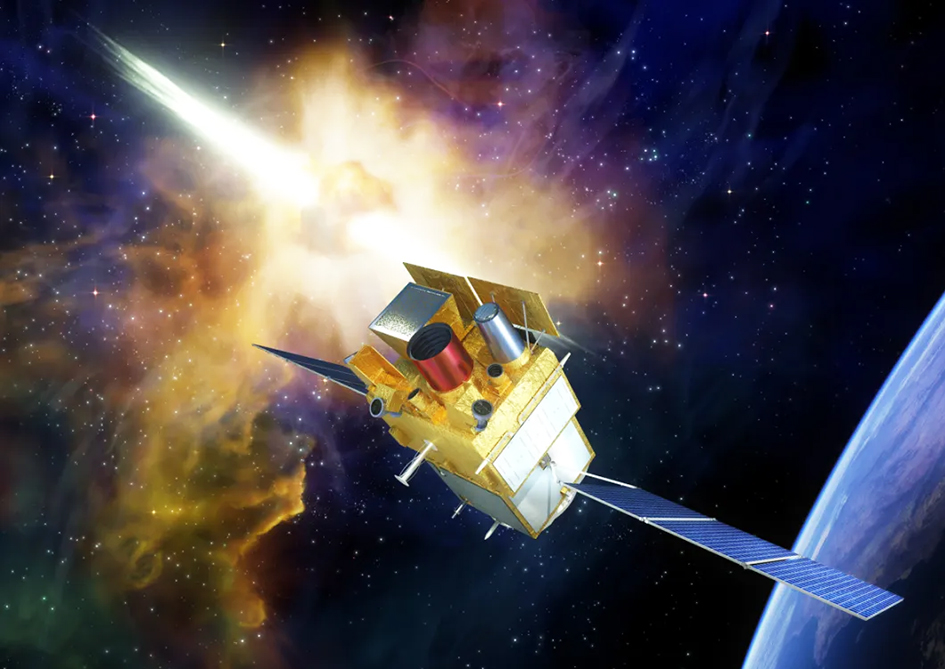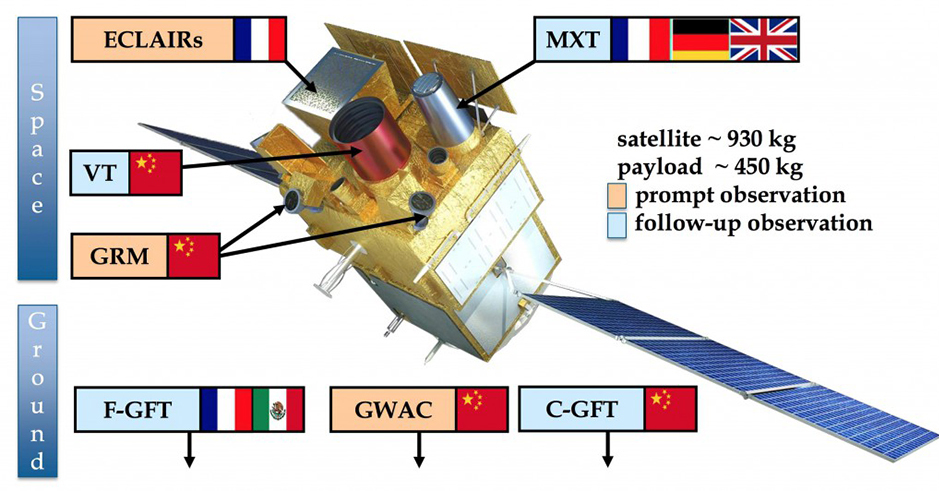By SONG Jianlan
SVOM, the Space-based multi-band Variable Objects Monitor, announced on April 23 the detection of over 100 gamma-ray bursts (GRBs), as part of the first results from its in-orbit calibration and commissioning observation after launching in last June. With the release of these successful results, it was officially delivered to science users as the most powerful instrument so far for multi-band GRB observations.

SVOM (Credit: microsat, CAS)
GRBs represent the most violent explosions in the universe — only second to the Big Bang. With their brief pulses lasting for only milliseconds to minutes, they can each unleash an amount of energy surpassing the total sum our dear Sun can release in its whole lifetime. The magical reactions that have triggered such fierce bursts thus become a hot topic of research: they are often associated with some prominent cosmic events like supernovae or merging of compact objects, and observations and analyses of their detailed processes can potentially yield insights into some long-pursued open questions in astrophysics and fundamental physics.
Set to observe and explore GRBs, the SVOM satellite is jointly developed by the Chinese National Space Agency (CNSA), Chinese Academy of Sciences (CAS) and the Centre National d’Études Spatiales (CNES). After 10 months in-orbit calibration and tests, it proved its excellent performance as designed, demonstrating advantages in multi-band coverage, autonomous swift response, accurate and stable observation, and ability to trigger global synchronized observation with ground-based instruments.
Encouraging Results
Through joint observations with ground-based instruments, SVOM obtained the spectral redshifts for 22 of the detected GRBs. Among them, the most spectacular is GRB 250314A, a long burst with a redshift of 7.3. At this high redshift, the observed signals have come from 13 billion lightyears away, bursting out just about 730 million years after the Big Bang, a very early time of our 13.8-billion-year-old universe. According to SVOM team, it marks the third farthest GRB determined with spectroscopy redshift.
Analysis suggests that GRB 250314A might have originated from the collapse of a first-generation star of the cosmos. Such stars formed in the cooling process in wake of the Big Bang. The wreckage could have formed a blackhole or a neutron star, which then exploded to give off the fierce radiations as GRB 250314A. The observational data produced by SVOM, recording different electromagnetic compositions of the long burst, might bring clues about the infancy of the cosmos.
A short burst, named GRB 241105A, also caught the eye of scientists. With a redshift of 2.681, it updated the record for the farthest short-duration GRB detected. Analysis indicates that it could be triggered by a merging event involved with two neutron stars.
SVOM also detected some evidence for connections between supernova and GRBs that give off lots of X-rays. This might help scientists better understand the origin of such GRBs. On the other hand, it recorded some long-sustained bursts of GRBs, offering important data for explorations into the central engine activities and possible GRB precursors.

SVOM (Credit: microsat, CAS)
Results released also include the discovery of delayed optical radiations from GRBs, which provides direct clues for the physics underlying the slowly declining compositions in their X-ray afterglows; and the revelation of a GRB hidden in a thick envelope of matter clouds. Filling a long-existing gap with high-quality data, the observation will help revise the theoretical models for GRB afterglows.
Versatile Observatory
Covering multiple wavebands, the instruments onboard have endowed SVOM with comprehensive capacity for monitoring and observing different phases and compositions of the GRB radiation. Among them, the Gamma-ray Monitor (GRM) is designed to monitor and observe high-energy bursts of energies from 15 keV to 5000 keV, and the Visible Telescope (VT), an optical telescope, is for the detection of visible emissions as afterglows of the GRBs. The Microchannel X-ray Telescope (MXT) works in the soft X-ray band (0.2 to 10 keV), and the instrument Eclairs works in the X-ray and low-energy gamma-ray bands (from 4 to 150 keV) to detect and localize GRBs. The GRM and TV are developed by China, and the MXT and Éclairs by France.
Part of the instruments onboard are designed for wide-field scanning and searching for objects, capable of covering one fourth of the sky at just a glance (with a field-of-view of around 10,000 square degrees); and the others for accurate follow-up observations targeted on the potential objects detected in the scanning and monitoring. Once the satellite detects potential GRBs in its scanning, it can automatically trigger follow-up observations in gamma, X-ray and optical bands. Meanwhile, the satellite’s in-orbit observation is complemented by ground-based instruments, including a wide-field camera called Ground-based Wide Angle Camera (GWAC) for optical observation, and a set of robotic telescopes located across continents called Ground Follow-up Telescopes (GFTs) for localization of the bursts. The latter can not only accurately measure the celestial coordinates of the targeted objects, but also the photometric evolution of the emissions in a range of frequencies extending from visible to infrared bands. Moreover, the satellite can further initiate synchronized observations joined by both space- and ground-based instruments across the world, through swiftly sharing the localization of detected objects.

The SVOM instruments: Space- and ground-based (Credit: CEA/IRFU)
Via the joint observation by its space- and ground-based instruments, SVOM can detect and rapidly localize GRBs of different types, and measure different electromagnetic compositions of them. This will offer scientists with opportunities to comprehensively understand the nature of GRBs, and further explore a series of relevant issues, including the origin and physical nature of GRBs, and even dark energy and cosmic evolution. It can also lock on potential electromagnetic counterparts of gravity wave sources for follow-up observations.
During its in-orbit calibration and tests, SVOM performed a number of joint observations with the Einstein Probe (EP), a powerful wide-field X-ray focusing imager developed by CAS in cooperation with European partners. The VT-SVOM/VT performed rapid follow-up observations for 20 X-ray transients discovered by EP. It successfully detected the optical counterparts for 14 of them, and shared the results with the global scientific community. The joint observations verified the satellite’s ability of rapid response and advantages in detecting optical counterparts of GRBs, laying basis for later synchronized observations with other space-based detectors.
SVOM will keep operating in orbit for at least three years. Its future observations are anticipated to further promote the explorations in time domain astronomy.

